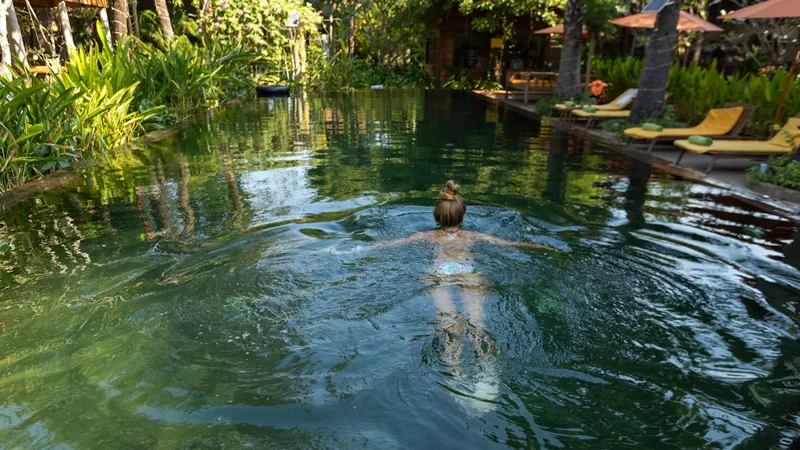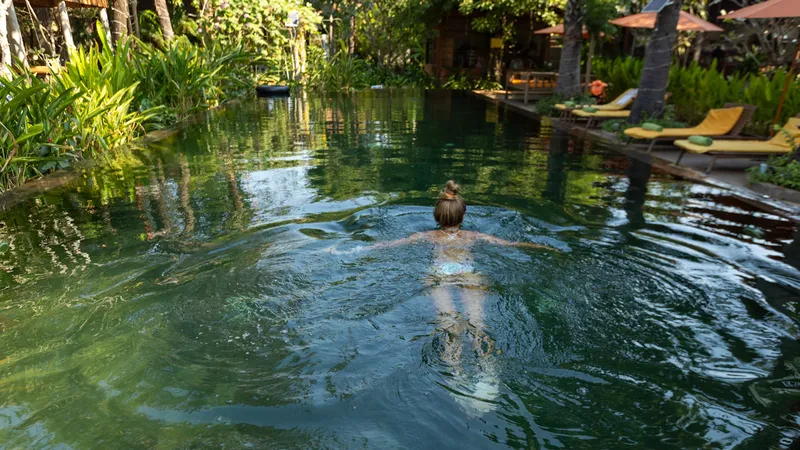
Sustainable swimwear is transforming the fashion industry by addressing environmental concerns. Brands now use innovative materials like recycled polyester and regenerated nylon to reduce waste and pollution. However, creating eco-friendly swimwear is not as simple as it seems. The production process often involves challenges, such as managing microplastic pollution and ensuring ethical labor practices. Additionally, natural fibers, though eco-friendly, lack the durability required for swimwear. Companies like TideLine Swimwear strive to balance sustainability with functionality, offering options that are better for the planet and your skin. For more details, feel free to contact us.
Key Takeaways
- Sustainable swimwear often uses recycled materials, but sourcing and processing these can be energy-intensive and may still contribute to pollution.
- Microplastics released from synthetic swimwear during washing pose a significant threat to marine ecosystems, highlighting the need for better material solutions.
- Caring for sustainable swimwear requires special attention, such as avoiding hot water and harsh detergents, to maintain its quality and longevity.
- Ethical labor practices are crucial; consumers should seek brands that ensure fair wages and safe working conditions in their supply chains
- Higher production costs for sustainable swimwear often lead to premium pricing, making it less accessible for budget-conscious consumers.
- Transparency is key in combating greenwashing; look for reputable certifications to verify a brand's sustainability claims.
- Supporting brands that invest in research and innovation can help drive the development of truly eco-friendly and high-performance swimwear options.
Environmental and Material Limitations in Sustainable Swimwear

Reliance on Recycled Plastics
Challenges with sourcing and processing recycled materials.
Recycled plastics, such as polyester and nylon, are widely used in sustainable swimwear. These materials reduce waste by repurposing discarded plastics like fishing nets and water bottles. However, sourcing these materials presents significant challenges. Recycling facilities often lack the capacity to meet the growing demand for high-quality recycled fibers. Additionally, the recycling process itself requires energy-intensive procedures, which can contribute to greenhouse gas emissions. This creates a paradox where efforts to reduce waste may still leave an environmental footprint.
Environmental concerns, such as microplastics released during use and washing.
Swimwear made from recycled plastics often sheds microplastics during use and washing. These tiny fibers enter waterways and harm marine ecosystems. Research shows that recycled polyester releases 2.3 times more microfibers than conventional polyester. Synthetic materials like nylon and spandex also contribute to this pollution. Over time, these microplastics accumulate in oceans, threatening marine life and entering the food chain. While sustainable swimwear aims to reduce waste, its reliance on synthetic fibers poses a serious environmental challenge.
Material Constraints and Care Requirements
The inability to print or dye sustainable swimwear due to material properties.
Sustainable swimwear materials often have limitations when it comes to customization. Many eco-friendly fabrics struggle to hold dyes or prints effectively. This restricts design options and makes it harder for brands to offer diverse styles. For consumers, this means fewer choices in patterns and colors compared to traditional swimwear. While sustainability remains the priority, these constraints can impact the overall appeal of the product.
Care limitations, such as avoiding hot water to prevent hardening and loss of smooth texture.
Caring for sustainable swimwear requires extra attention. Hot water can damage the fabric, causing it to harden or lose its smooth texture. You must avoid harsh detergents and high temperatures to maintain the material's integrity. These care requirements may feel inconvenient, especially for those accustomed to low-maintenance swimwear. Proper care, however, extends the lifespan of the product and reduces the need for frequent replacements.
The environmental trade-offs of using synthetic materials derived from fossil fuels.
Most sustainable swimwear relies on synthetic materials like ECONYL®, a regenerated nylon made from waste. While these materials reduce landfill waste, they are still derived from fossil fuels. This creates an environmental trade-off. On one hand, they repurpose existing waste; on the other, they perpetuate reliance on non-renewable resources. Balancing these factors is crucial for the future of sustainable swimwear. Brands must explore innovative solutions to minimize these trade-offs while maintaining functionality.
Production Challenges in Sustainable Swimwear
Ethical Labor Practices
Ensuring fair wages and safe working conditions in the supply chain.
When you choose sustainable swimwear, you may assume that ethical labor practices are part of the package. However, ensuring fair wages and safe working conditions remains a significant challenge for many brands. The global supply chain often involves multiple countries, each with varying labor laws and enforcement standards. Some manufacturers fail to provide workers with adequate pay or safe environments, even when producing eco-friendly products.
To address this, brands must actively monitor their supply chains and partner with factories that prioritize worker welfare. Transparency plays a crucial role here. Companies that openly share details about their production processes help you make informed decisions. By supporting brands committed to ethical practices, you contribute to a system that values both people and the planet.
Addressing concerns about modern-day slavery in manufacturing.
Modern-day slavery continues to plague the fashion industry, including the production of sustainable swimwear. Exploitative practices, such as forced labor and human trafficking, often occur in regions with weak labor protections. These issues undermine the ethical foundation of sustainability.
As a consumer, you can look for certifications like Fair Trade or SA8000, which indicate that a brand adheres to ethical labor standards. Brands must also take responsibility by conducting regular audits and collaborating with organizations that combat labor exploitation. Your demand for transparency and accountability can push the industry toward more ethical practices.
Cost and Scalability Issues
Higher production costs compared to conventional swimwear.
Producing sustainable swimwear often costs more than making traditional options. Eco-friendly materials like recycled nylon or organic fabrics come with higher price tags due to their sourcing and processing requirements. Additionally, ethical labor practices and environmentally conscious manufacturing add to the overall expense.
These higher costs frequently translate into premium pricing for you as a consumer. While the investment supports sustainability, it can feel out of reach for many. Brands face the challenge of balancing these costs while maintaining quality and affordability. By understanding the factors behind the pricing, you can appreciate the value of choosing sustainable options.
The challenge of balancing affordability with sustainability.
Affordability remains a barrier for many consumers interested in sustainable swimwear. Limited budgets often lead you to prioritize cost over eco-friendliness. For brands, scaling production to reduce costs without compromising sustainability is a complex task. Larger production runs can lower prices, but they require significant upfront investment and market demand.
To make sustainable swimwear more accessible, some companies explore innovative solutions like using alternative materials or adopting efficient production methods. As demand for eco-friendly products grows, economies of scale may help reduce prices over time. Your support for sustainable brands encourages this progress and helps make ethical swimwear a viable option for more people.
Consumer-Related Issues with Sustainable Swimwear
Accessibility and Affordability
The premium pricing of sustainable swimwear and its impact on consumer accessibility.
Sustainable swimwear often comes with a higher price tag. Brands use eco-friendly materials like recycled nylon or organic fabrics, which cost more to produce than conventional options. Ethical labor practices and environmentally conscious manufacturing further increase production expenses. These factors result in premium pricing that can feel out of reach for many consumers.
This pricing creates a barrier, especially for those who want to make eco-conscious choices but have limited budgets. While the investment supports sustainability, it may discourage some from purchasing. To address this, brands must explore innovative ways to reduce costs without compromising quality. As demand grows, economies of scale could help lower prices, making sustainable swimwear more accessible to a broader audience.
Limited styles, sizes, and availability compared to traditional swimwear options.
Sustainable swimwear often lacks the variety found in traditional swimwear. Many eco-friendly brands offer limited styles, sizes, and designs due to constraints in material properties and production processes. This can make it challenging for you to find options that suit your preferences or body type.
For example, some sustainable fabrics cannot hold vibrant prints or intricate patterns, limiting design possibilities. Additionally, smaller brands focusing on sustainability may not have the resources to produce a wide range of sizes or styles. This lack of diversity can make sustainable swimwear less appealing, even for eco-conscious shoppers. Expanding options in this market is essential to meet the needs of diverse consumers.
Greenwashing and Transparency
Misleading marketing claims about sustainability.
Greenwashing has become a significant issue in the sustainable swimwear industry. Some brands exaggerate or misrepresent their eco-friendly efforts to attract consumers. For instance, a company might highlight the use of recycled materials while ignoring unethical labor practices or other unsustainable aspects of production. These misleading claims can make it difficult for you to identify genuinely sustainable products.
To avoid falling for greenwashing, look for certifications like Global Recycled Standard (GRS) or OEKO-TEX, which verify a brand's sustainability claims. Researching a company's practices and seeking transparency in their supply chain can also help you make informed decisions. Supporting brands that prioritize honesty and accountability encourages the industry to adopt more ethical practices.
The difficulty for consumers to verify eco-friendly claims and certifications.
Verifying the sustainability claims of swimwear brands can be a daunting task. Many certifications and labels exist, but not all are reliable or widely recognized. Some brands use vague terms like "eco-friendly" or "green" without providing concrete evidence to back their claims. This lack of clarity makes it hard for you to determine whether a product truly aligns with your values.
To navigate this challenge, familiarize yourself with reputable certifications and what they represent. For example, Fair Trade certification ensures ethical labor practices, while GRS focuses on recycled content. Brands that openly share details about their materials, production processes, and certifications demonstrate a commitment to transparency. By choosing such brands, you can support genuine sustainability efforts and encourage others to follow suit.
Technological and Innovation Gaps in Sustainable Swimwear

Current Limitations in Technology
The lack of truly biodegradable or circular materials for swimwear.
Creating swimwear that is both high-performing and fully biodegradable remains a significant challenge. Most swimwear relies on synthetic fibers like nylon and spandex, which are non-biodegradable and derived from fossil fuels. These materials persist in the environment for decades, contributing to pollution. While recycled alternatives like ECONYL® reduce waste, they do not solve the issue of biodegradability. A truly circular material—one that can decompose naturally without harming ecosystems—has yet to be developed for swimwear.
The fashion industry has made strides in using upcycled materials, but this approach only delays the inevitable environmental impact. For example, regenerated nylon reduces the need for virgin materials but still produces greenhouse gases during manufacturing. The absence of biodegradable options highlights the urgent need for innovation in material science. You, as a consumer, can support brands investing in research to address this gap.
Challenges in creating durable, high-performance fabrics that are also sustainable.
Swimwear must endure harsh conditions like saltwater, chlorine, and UV exposure. Achieving this durability while maintaining sustainability is a complex task. Synthetic fibers excel in performance but come with environmental drawbacks. Natural fibers, though eco-friendly, often lack the elasticity and water resistance required for swimwear. For instance, organic cotton absorbs water and loses its shape, making it unsuitable for prolonged use in aquatic environments.
Balancing performance with sustainability requires advanced technology. Current options often involve trade-offs, forcing you to choose between functionality and environmental responsibility. This limitation underscores the need for breakthroughs in fabric engineering. By supporting brands that prioritize innovation, you contribute to the development of better solutions.
Opportunities for Future Innovation
The need for research and development in sustainable textiles.
Research and development (R&D) hold the key to overcoming the technological barriers in sustainable swimwear. Scientists and textile engineers are exploring alternatives like bio-based polymers and algae-derived fabrics. These materials show promise in reducing reliance on fossil fuels and improving biodegradability. However, they are still in the experimental phase and require significant investment to scale up for commercial use.
You can play a role by choosing brands that allocate resources to R&D. Companies that invest in sustainable textiles not only advance the industry but also set an example for others to follow. Supporting such initiatives accelerates the transition toward more eco-friendly swimwear options.
Collaboration between fashion brands and technology companies to drive progress.
Collaboration between fashion brands and technology firms can revolutionize the sustainable swimwear industry. Tech companies bring expertise in material science and innovation, while fashion brands understand consumer needs and market trends. Together, they can develop fabrics that combine durability, performance, and sustainability.
For example, partnerships could focus on creating closed-loop systems where swimwear materials are recycled indefinitely without quality loss. Such collaborations also pave the way for smart textiles that adapt to environmental conditions, enhancing both functionality and sustainability. By choosing brands that engage in these partnerships, you encourage a culture of innovation and responsibility.
Sustainable swimwear presents unique challenges that require your attention as a conscious consumer. Material limitations, ethical production concerns, and technological gaps highlight the complexity of creating truly eco-friendly options. Transparency from brands plays a vital role in helping you make informed choices. Companies like Tideline Swimwear and VYB Swim demonstrate how ethical practices and sustainability can coexist by ensuring fair wages, reducing carbon footprints, and embracing innovative materials. By supporting such brands, you contribute to a more responsible fashion industry and encourage progress toward a sustainable future.
FAQ
What makes sustainable swimwear eco-friendly?
Sustainable swimwear uses materials like recycled nylon, polyester, or other regenerated fibers. These fabrics repurpose waste, such as discarded fishing nets or plastic bottles, reducing environmental harm. Ethical production practices, including fair wages and safe working conditions, also contribute to sustainability. By choosing these options, you support a cleaner planet and responsible manufacturing.
How should I care for my sustainable swimwear to ensure its durability?
Proper care extends the life of your swimwear. Always rinse it with cold water after use to remove salt, chlorine, or sunscreen residue. Avoid hot water, as it can damage the fabric's texture. Use mild detergents and air-dry your swimwear instead of using a dryer. These steps help maintain its quality and reduce the need for frequent replacements.
Why does sustainable swimwear cost more than traditional options?
Eco-friendly materials and ethical labor practices increase production costs. Recycled fabrics require specialized processing, and ensuring fair wages adds to expenses. While the price may seem higher, it reflects the true cost of sustainability. Investing in these products supports ethical practices and reduces environmental impact.
Can sustainable swimwear match the performance of traditional swimwear?
Yes, sustainable swimwear can perform just as well. Brands use advanced materials like ECONYL® to ensure durability, elasticity, and resistance to chlorine and UV rays. While some natural fibers lack these qualities, innovative technologies make eco-friendly options suitable for active use.
Are there biodegradable options for swimwear?
Currently, most swimwear relies on synthetic fibers, which are not biodegradable. While recycled materials like ECONYL® reduce waste, they do not decompose naturally. Researchers are exploring bio-based fabrics, but these options are still in development. Supporting brands investing in innovation can help accelerate progress.
How can I verify if a brand's swimwear is truly sustainable?
Look for certifications like Global Recycled Standard (GRS) or OEKO-TEX. These labels confirm the use of eco-friendly materials and ethical practices. Research the brand's transparency regarding its supply chain and production methods. Brands that openly share this information demonstrate genuine commitment to sustainability.
Does sustainable swimwear come in a variety of styles and sizes?
Sustainable swimwear often has fewer style and size options compared to traditional swimwear. Material constraints and smaller production scales limit diversity. However, many brands are expanding their collections to include more designs and inclusive sizing. Supporting these efforts encourages further growth in the market.
What are the environmental trade-offs of using recycled materials in swimwear?
Recycled materials reduce waste but still rely on synthetic fibers derived from fossil fuels. They also release microplastics during washing, which harm marine ecosystems. While these materials are a step forward, they highlight the need for continued innovation to minimize environmental impact.
How can I identify greenwashing in sustainable swimwear marketing?
Greenwashing occurs when brands exaggerate their eco-friendly claims. Be cautious of vague terms like "green" or "eco-conscious" without evidence. Check for certifications and detailed information about materials and production processes. Brands that prioritize transparency help you make informed choices.
Is sustainable swimwear worth the investment?
Yes, sustainable swimwear offers long-term value. It supports ethical practices, reduces environmental harm, and often lasts longer with proper care. While the upfront cost may be higher, the benefits for the planet and future generations make it a worthwhile choice.
